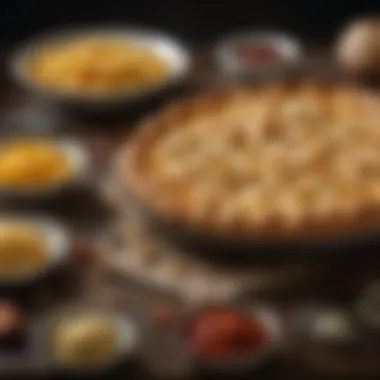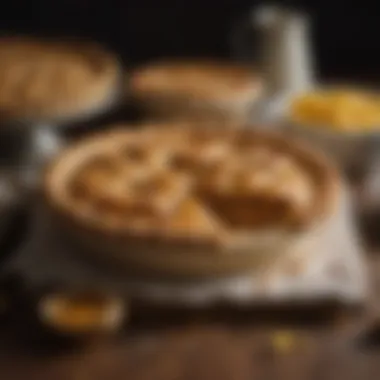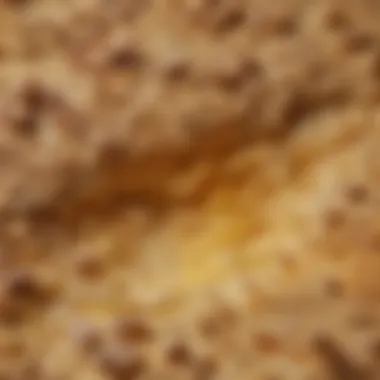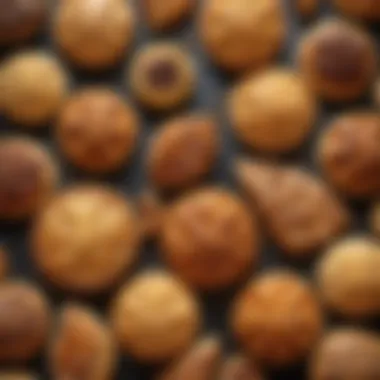Mastering the Art of Flaky Crusts


Intro
Creating a flaky crust is an art that combines precision, technique, and an understanding of the ingredients involved. In the realm of baking, few things are as satisfying as a perfectly structured flaky crust that cradles a rich filling. This section will guide you through the essentials of this crucial culinary component, offering insights into both its scientific basis and practical applications.
The relevance of mastering flaky crusts cannot be overstated. Whether you are preparing a classic apple pie, a savory quiche, or delicate pastries, the foundation lies in the crust. A flaky crust provides not just texture and flavor, but also enhances the overall presentation of the dish. Thus, understanding the nuances of this element can elevate one's baking from mere food preparation to a refined culinary experience.
In the subsequent sections, we will delve deeper into the specific aspects that contribute to achieving that perfect flakiness. From the selection of ingredients to advanced techniques and common pitfalls, this guide is designed to empower food lovers with knowledge and skills to confidently explore the world of flaky crusts.
Preamble to Flaky Crust
The flaky crust is a defining feature in a variety of baked goods, and its significance cannot be understated. It serves as a crucial component in pies, quiches, tarts, and pasties, contributing texture and flavor to the overall dish. Understanding how to create a perfect flaky crust can elevate a simple dessert or main course into an exceptional culinary experience.
This article provides insights into the fundamentals of flaky crusts, focusing on the science that underpins flakiness and the considerations that should guide ingredient selection and preparation methods. By unraveling the complexities of flaky crusts, we aim to empower culinary enthusiasts with knowledge to achieve that coveted texture and flavor in their baking endeavors.
Definition and Importance
Flaky crust refers to a pastry that is characterized by its layers, leading to a light and tender yet surprisingly crisp texture. The layers form due to the incorporation of fat into the flour. This process creates small pockets in the structure, allowing the dough to expand and separate during baking.
The significance of a flaky crust lies in its ability to enhance both the aesthetics and taste of a baked good. A well-executed flaky crust offers contrast to fillings that may be creamy, fruity, or savory. The texture provides a delightful experience in each bite, making it an essential skill for anyone passionate about baking.
Culinary Uses of Flaky Crust
Flaky crusts have a wide range of culinary applications. They are essential in sweet dishes such as fruit pies, where the crispy layers complement the juicy filling perfectly. Similarly, in savory pies and tarts, flaky crusts can provide a satisfying crunch against rich fillings like cheese, vegetables, or meats.
Here are some common uses of flaky crusts:
- Pies: Both sweet and savory versions rely heavily on a flaky crust for structural integrity and texture.
- Tarts: Flaky crusts allow for intricate designs and can elevate the presentation of desserts.
- Quiches: Flaky crusts are ideal for quiches, helping keep the creamy filling contained while adding texture.
In summary, understanding flaky crust and its culinary uses is key in baking. It not only improves sensory experiences but also showcases the baker's skill. This foundational knowledge prepares enthusiasts for deeper exploration into the techniques and ingredients necessary for creating the perfect flaky crust.
The Science Behind Flakiness
Understanding the science behind flakiness is crucial for anyone seeking to master the art of creating the perfect flaky crust. This section examines the key elements that contribute to the desired texture, appearance, and overall quality of flaky baked goods. A firm grasp of these concepts allows bakers to make informed choices regarding ingredients and techniques, ultimately resulting in a superior crust. By delving into the role of fats, gluten development, and moisture distribution, one can appreciate the intricate balance necessary for achieving optimal flakiness.
Role of Fats in Dough
Fats play a pivotal role in the formation of flaky layers in pastry dough. When incorporated properly, they create a tender texture while simultaneously providing flavor. There are various types of fats, each influencing the final product differently.
- Butter: Often preferred due to its rich flavor, butter contains about 80% fat, which is vital for creating flakiness. As the butter melts during baking, it produces steam that helps separate the layers of dough.
- Shortening: This fat has a higher melting point than butter and can create even flakier textures. However, it lacks the nuanced flavor that butter provides.
- Lard: A traditional choice for flaky crusts, lard contributes a distinctive taste and texture, often resulting in a particularly flaky crust.
Incorporating fats into the dough should be done with care. The goal is to avoid complete integration with the flour. Instead, the dough should have pea-sized pieces of fat throughout. These pieces will melt during baking to create steam, effectively lifting the layers of dough apart.
Gluten Development
Gluten is a protein formed when flour is mixed with water. It contributes to the structure and elasticity of dough. However, for flaky crusts, controlling gluten development is essential.
- Minimizing Gluten: Overworking the dough will enhance gluten formation, leading to a tough crust. It is important to mix the ingredients just until combined, thus preserving tenderness.
- Choice of Flour: The type of flour also affects gluten levels. All-purpose flour has a moderate gluten content, while cake flour has less gluten, which can promote a flakier crust.
- Resting the Dough: Allowing the dough to rest is crucial. This resting period lets gluten relax, which helps achieve a more tender texture in the final baked product.
Moisture and Fat Distribution
The interplay between moisture and fat distribution significantly influences the final texture of a flaky crust. Proper balance here can determine whether a crust achieves the desired layers or becomes dense and doughy.
- Liquid Integration: The type and amount of liquid used can impact the overall texture. Too much liquid can promote gluten formation, while too little may not hydrate the flour adequately.
- Chilling: Keeping the dough cold during preparation helps solidify the fat, which assists in achieving a flaky texture. It is recommended to chill the formed dough before rolling it out, ensuring that the fat remains dispersed throughout.
- Even Distribution: Ensuring the fat is evenly distributed in the dough during mixing prevents uneven melting during baking, promoting consistent steaming and layer formation.
"Understanding the science of flaky crusts is about more than just following a recipe; it’s about recognizing the interactions between ingredients and techniques."


In summary, mastering the science behind flakiness involves a nuanced approach to fats, gluten, and moisture. Each element plays a critical role in crafting a superior flaky crust, making it essential for bakers to consider these factors carefully.
Core Ingredients for a Flaky Crust
The core ingredients in making a flaky crust are crucial to achieving the desired texture and flavor. Each ingredient contributes distinct properties that affect the final result. Understanding these components not only enhances your culinary creations but also empowers you to make informed choices in your baking endeavors.
Flour: Types and Their Effects
Flour is the foundation of any pastry. Different types of flour yield varying textural results. For flaky crusts, all-purpose flour is commonly used, as it has a moderate protein content. This protein level provides enough gluten structure without developing too much elasticity.
Consider also the use of pastry flour. It has a lower protein percentage and is ideal for creating tender, delicate crusts. Conversely, bread flour is higher in protein and can lead to a tougher, less desirable crust when it is overworked. Understanding how these flours interact with fats and liquids is crucial.
"The choice of flour can drastically change the nature of the crust."
Key Points about Flour:
- All-Purpose Flour: Balanced protein for flakiness.
- Pastry Flour: Lower protein for tenderness.
- Bread Flour: Higher protein risks toughness.
Fats: Butter vs. Shortening
The type of fat used greatly influences the taste and flakiness of a crust. Butter is favored for its rich flavor and ability to create a flaky texture when worked in correctly. The water content in butter also contributes to steam during baking, aiding the flakiness.
Shortening, on the other hand, has a higher melting point and no water, which can create an even flakier crust. However, it lacks the flavor that butter provides. A combination of both is also an option, allowing bakers to achieve the best of both worlds.
Considerations on Fats:
- Butter: Flavorful, promotes flakiness, tends to be more easily overworked.
- Shortening: Creates flakiness, offers stability, less flavor.
- Combination: Balances flavor and texture for varied results.
Liquid: Water, Milk, and Alternatives
Liquid plays a fundamental role in binding the dry ingredients. Water is the most used liquid, but the choice can vary depending on the desired outcome. Water creates a basic dough, while milk adds fat and flavor, resulting in a richer crust.
Non-dairy alternatives, such as almond milk or coconut milk, can also be considered. These can affect both the taste and texture, allowing for creative variations. The amount of liquid must be measured precisely as too much can lead to a tough dough, and too little can result in an inability to hold together.
Key Points on Liquid:
- Water: Basic bonding agent, straightforward and traditional.
- Milk: Adds creaminess, flavor, and nutritional value.
- Alternatives: Flexibility for dietary preferences; think through texture changes.
Understanding these core ingredients provides an essential framework for creating an exquisite flaky crust. Each element contributes its unique characteristics, enabling the craftsman to innovate and perfect their baking skills.
Techniques for Crafting Flaky Crust
The art of creating a flaky crust lies in mastering a handful of essential techniques. Each step serves as a building block toward achieving that coveted texture. These techniques ensure the proper balance of fat and flour while optimizing gluten formation. Understanding these practices not only enhances the quality of your baked goods but also builds confidence in your baking skills.
Cutting in the Fat
Cutting in the fat is crucial for achieving a flaky texture. This process involves incorporating solid fats, like butter or shortening, into the flour until the mixture resembles coarse crumbs. The goal here is to create small pieces of fat coated in flour. This prevents the fat from melting into the dough during baking, allowing instead for the formation of steam pockets which results in flakiness.
There are several methods for cutting in the fat:
- Pastry Cutter: A classic tool, effective in breaking down fat into the flour evenly.
- Fork: A simple yet effective option for smaller batches.
- Food Processor: Suitable for larger quantities, it will get the job done quickly.
Once you cut in the fat, the dough will be ready for the next step. Remember, the less the fat is worked into the flour, the better the crust will be.
Chilling the Dough


Chilling the dough is often overlooked but is essential in flaky crust preparation. This technique allows the fats to solidify. When the chilled dough hits the oven, the solidified fat melts and creates steam. This steam lifts the layers, giving the crust its characteristic flakiness.
It is advisable to chill the dough for at least 30 minutes. If you have time, a longer chill can improve flavor and texture. When working with a warm kitchen environment, chilling frequently can help prevent the dough from becoming too soft. Wrap the dough in plastic wrap or place it in a sealed container to avoid drying out.
Rolling Techniques
The way you roll the dough contributes significantly to its texture. Proper rolling ensures that the layers of fat remain intact, further encouraging that flaky quality. Here are some important considerations:
- Use a Light Hand: Roll gently to avoid overworking the gluten, which can result in a tough crust.
- Dust with Flour: A light dusting of flour on the surface and rolling pin prevents sticking without adding excess flour, which may toughen the dough.
- Roll from the Center: Start from the center of the dough towards the edges. This technique helps maintain an even thickness.
By focusing on these rolling techniques, the dough will be uniformly flat and ready for shaping into pies or tarts. Successful application will lead to a visually appealing, flaky crust that impresses both the eyes and the palate.
Mastering these techniques allows you to elevate your baking from ordinary to exceptional, showcasing the beautiful, flaky crust as the centerpiece of your culinary creations.
Common Challenges in Making Flaky Crusts
Making a flaky crust can be a rewarding experience, but it is not without its hurdles. Understanding the common challenges can significantly improve your baking skills and lead to a more enjoyable outcome. The flaky texture is often the goal, but obstacles may arise that hinder this achievement. Here are some specific aspects to consider during the baking process.
Dough Cracking
One of the most visible issues encountered is dough cracking. It often occurs when the dough is too dry or over-rolled. A dry environment will lead to moisture loss in the dough, reducing elasticity. When rolling out the dough, it is crucial to apply even pressure. Uneven rolling can also contribute to weaken integrity. To mitigate this issue, maintain a proper ingredient ratio, ensuring adequate fat and liquid content. When relaxing the dough before rolling, consider covering it to retain moisture.
Tips to avoid dough cracking include:
- Maintaining proper hydration: Ensure you measure the liquid accurately.
- Using cold ingredients: Cold fat helps in minimizing melt, which keeps the structure intact.
- Chilling the dough: Keeping the dough cool prevents overworking and retains flakiness.
"A well-prepared dough is the backbone of a successful flaky crust."
Soggy Bottoms
The presence of soggy bottoms is another prevalent challenge. This issue typically arises during the baking process, where moisture from fillings seeps into the crust, causing it to become limp. It is common in fruit pies and quiches where moisture content is high. To counter this problem, pre-baking or blind-baking the crust can be effective. This method involves baking the crust without a filling to provide a crisp foundation.
To improve the crust texture and avoid sogginess:
- Pre-bake the crust: Consider blind-baking for at least 15 minutes.
- Use a thickener in fillings: Cornstarch or flour helps absorb extra moisture.
- Cool fillings before adding them to the crust: This can minimize the moisture being transferred.
Overworking the Dough
Overworking the dough is a frequent error encountered when making flaky crusts. It occurs when the dough is mixed or rolled excessively. Overworked dough can lead to the development of gluten, leading to tough instead of flaky textures. Achieving the right balance is key here. The dough should be mixed just enough for ingredients to come together without over-kneading.
To prevent overworking:
- Handle the dough gently: Use a light touch during mixing and rolling.
- Rest periods: Allow the dough to rest after mixing, which helps relieve tension.
- Chill the dough: Cooling helps to firm it without compromising flakiness.
By being aware of these common challenges, bakers can better navigate the process of creating a flaky crust. The understanding of potential hurdles aids in taking the necessary precautions to achieve the desired results.
Flavorful Variations of Flaky Crust
The concept of flavorful variations in flaky crust is essential to enhance the overall taste and presentation of baked goods. While the basic flaky crust serves as a versatile foundation, incorporating different flavors transforms ordinary recipes into extraordinary culinary experiences. Whether by adding herbs, changing flour types, or adjusting sweetness, each variation brings unique characteristics to the crust and complements the filling.
When experimenting with flavor variations, it is vital to consider the types of dishes being prepared. For instance, a pie suited for a summer fruit filling might benefit from subtle herbs, while a savory tart can shine with bolder spices. Choosing ingredients wisely ensures that the crust not only supports but also elevates the main components of the dish.
Herbed and Spiced Crusts
Herbed and spiced crusts offer a robust alternative to traditional flaky crusts. By integrating herbs like thyme, rosemary, or even dill, bakers can infuse depth into their dishes. The process usually involves finely chopping fresh herbs or using dry herbs mixed directly into the dry ingredients before adding fat and liquid. This method distributes the herb's flavor evenly throughout the crust.


Spices can also add interest. A pinch of ground cinnamon may be a curious addition in sweet pies, while a hint of cayenne can add warmth to savory options. The balance of flavors is critical, and bakers should experiment to find combinations that suit their palettes. Integrating green herbs or earthy spices transforms the crust into an integral part of the flavor profile.
Whole Wheat and Alternative Flours
Using whole wheat or other alternative flours represents another way to diversify crust flavors. Whole wheat flour brings a nutty essence that complements both sweet and savory fillings. It is richer in fiber, making it a healthier choice as well. However, it absorbs more liquid than all-purpose flour. Therefore, adjusting the moisture content during mixing becomes crucial.
Other alternative flours, such as almond flour or gluten-free options, can cater to dietary preferences while introducing different textures and flavors. Each flour has distinct properties, giving bakers a chance to innovate with crusts that suit their needs. Experimentation is vital to achieve the desired consistency and taste.
Sweet vs. Savory Crusts
The distinction between sweet and savory crusts is paramount for any chef. Sweet crusts often utilize sugar in the dough and are typically paired with fruit or creamy fillings. Ingredients such as brown sugar or vanilla extract can profoundly influence the taste and aroma of these crusts, making them ideal for desserts.
Conversely, savory crusts may include cheese or herbs right into the mix. Cheddar or parmesan elevates the flavor and suits quiches or savory tarts. Balancing these flavors with the filling is fundamental. A pie with a meat filling demands a crust that can support its robust flavors without being overwhelmed.
Classic Recipes Featuring Flaky Crust
Classic recipes featuring flaky crust are essential in showcasing the versatility and texture of this culinary staple. From sweet to savory, flaky crust serves as the foundational element that elevates many dishes. It is important to note how its texture enhances the eating experience. When baked properly, flaky crust offers a delightful contrast to the fillings it encases, providing a satisfying crunch complemented by a tender, buttery flavor. This section will cover three main types of classic recipes: fruit pies, savory pies and tarts, and quiches. Each of these recipes not only utilizes the flaky crust but also highlights its adaptability in various culinary contexts.
Fruit Pies
Fruit pies are a perfect illustration of a classic recipe that thrives on a flaky crust. The balance of sweet, juicy fruit filling against the crisp texture of the crust is one of the key pleasures of this dish. Seasonal fruits, such as apples, cherries, and peaches, can be featured, creating vibrant flavors that burst in every bite. Properly incorporating the flaky crust here means paying attention to various factors, including the thickness of the crust, the chilling process, and the baking time. The crust must be par-baked slightly to prevent sogginess from the fruit juices, while still allowing for that coveted flaky finish.
Savory Pies and Tarts
Savory pies and tarts often utilize flaky crust in a unique way to highlight ingredients like vegetables, meats, and cheeses. These dishes can range from simple vegetable tarts to elaborate pot pies, with each recipe benefiting from the layered texture of the crust. A well-crafted flaky crust complements and enhances the flavors of the fillings. Important considerations here include seasoning the crust itself, which can add another layer of aroma, as well as ensuring that the filling has a balanced moisture level. Careful attention must be paid to the baking time to achieve a golden, flaky exterior while still ensuring the savory interior is cooked through.
Quiches
Quiches represent yet another classic recipe where flaky crust plays a crucial role. This egg-based dish combines cream, cheese, and various fillings such as spinach or bacon, all nestled in a flaky, golden shell. The crisp texture of the crust balances the rich, creamy filling, making each bite a delightful experience. As with other preparations, a proper flaky crust for quiche requires specific methods like pre-baking, which helps set the crust and prevents it from becoming too soggy. By achieving the right flakiness, quiches transform from a simple dish to a sophisticated culinary offering that is perfect for breakfast, lunch, or dinner.
In summary, classic recipes featuring flaky crust showcase both culinary expertise and creativity. They allow cooks to experiment with flavors and textures, creating memorable dishes that delight the senses and satisfy diverse palates.
Epilogue: Mastering the Flaky Crust
In the realm of baking, mastering the flaky crust is a pivotal accomplishment. It serves as a fundamental skill that enhances culinary creations, from sweet to savory dishes. The significance of this mastery extends beyond mere taste; it involves understanding the various scientific principles at play. Recognizing how ingredients interact and the techniques that are essential for achieving that desirable flakiness allows for greater creativity in the kitchen.
The benefits of a well-crafted flaky crust are manifold. It provides a delightful textural contrast to fillings, whether they are fruity, creamy, or meaty. Additionally, a flaky crust can elevate the overall aesthetic of a dish, making it more visually appealing. This aspect is particularly important in culinary presentations where the first impression holds weight.
Moreover, the attention devoted to crafting a perfect crust can lead to reduced cooking anxieties. Knowing the techniques and methods ensures a level of confidence in the baking process, which results in better outcomes. Creating a flaky crust can be also a gateway to exploring more advanced baking methods, thereby expanding one's culinary repertoire.
Effective consideration of the discussed elements can greatly improve one’s baking results:
- Recognizing the role of fats and moisture
- Understanding flour choices and gluten development
- Employing appropriate techniques such as chilling and rolling
Mastering these components helps transform baking mishaps into successes, forging a deeper appreciation for the art and science of culinary innovation.
Key Takeaways
- Importance of Techniques: Utilizing proper techniques leads to a consistent flaky texture. Techniques such as cutting in fats and chilling dough are essential.
- Selection of Ingredients: The choice of flour and fats significantly impacts the final product. Choosing the right type of butter or shortening can make a difference.
- Understanding Challenges: Knowing common issues like dough cracking or soggy bottoms equips bakers to troubleshoot effectively.
- Encouragement for Creativity: Each variation in ingredients and techniques can result in unique flavors and textures, encouraging experimentation.
Encouragement for Exploration
Exploring the multifaceted world of flaky crust offers countless opportunities for discovery. Each baker is encouraged to experiment with different ingredient ratios, techniques, and flavors. Substituting whole wheat flour for all-purpose flour, or adding herbs to the dough, can yield delightful surprises.
For those new to baking, small adjustments can lead to remarkable improvements. Utilizing resources like community discussions on platforms such as Reddit can provide insights and tips from other home bakers.
Baking is a journey. Each attempt to create the perfect flaky crust contributes to overall knowledge and skill. So, do not hesitate to try new recipes or techniques. The process can be just as fulfilling as the product itself. Embrace each experience as a step towards mastering the flaky crust.
"Baking is about creativity and learning. Each crust tells a story, waiting for you to discover it."
By finding pleasure in the exploration of flaky crusts, bakers can create both simple and elaborate dishes, satisfying their palates and impressing their guests.







